#dead balagtas
Text


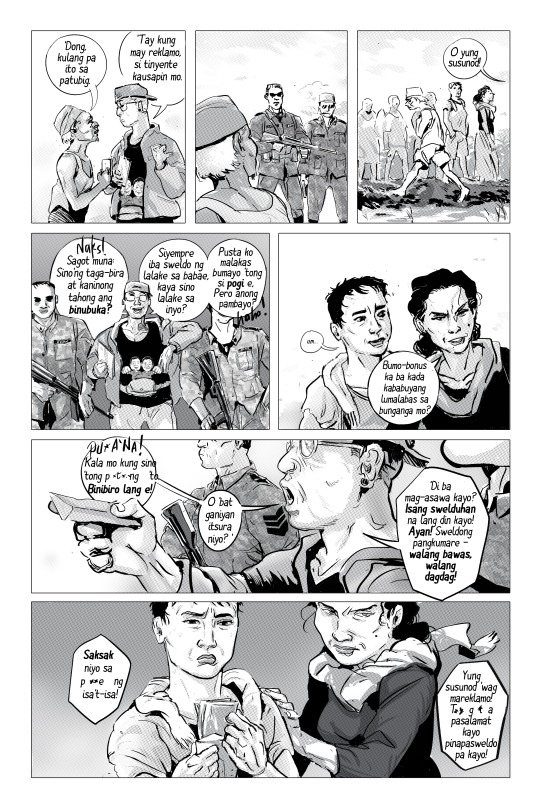
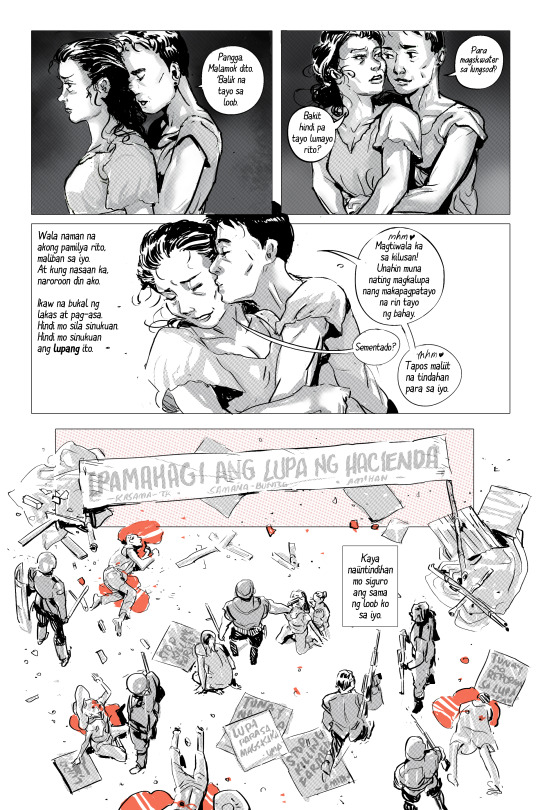
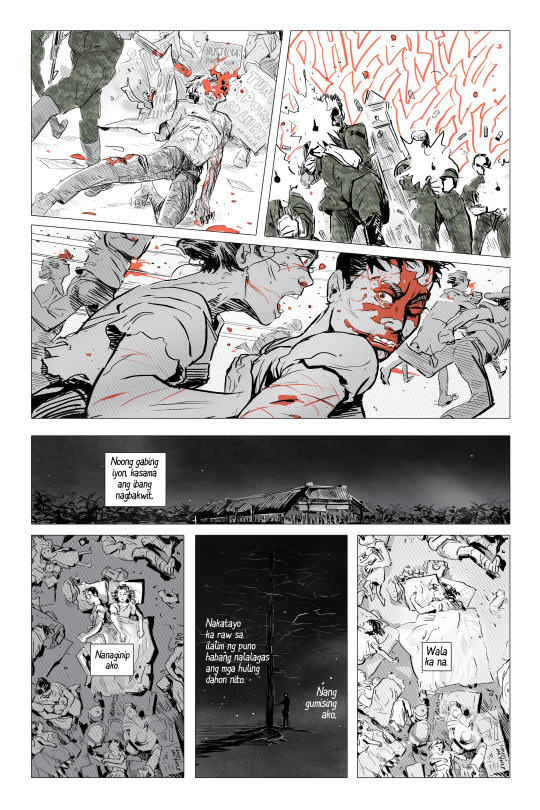



From my June 2019 komik, "Pula ang Unang Kulay ng Bahaghari" - Red is the First Color of the Rainbow
Please feel free to translate, mga kasama.
Thanks to everyone who reblogged/posted this on a forum. I don't really write that often or make komiks often as I have shifted my praxis to other org work. I've also become less inclined to maintain any presence. Still, maraming salamat (thank you very much) for promoting and appreciating my work.
#dead balagtas#filipino comics#wlw#girls love#comics#komiket#filipino komiks#komiks#sapphic#gay girls
151 notes
·
View notes
Text
Ride across the many worlds of Philippine komiks with Abangan
REVIEWS : COMICS
From heartbroken memoirs, to poetry comics, and yes, even superheroes, we can’t wait for Abangan: Best Philippine Komiks 2014
Originally published on Pacifiqa.com, April 2014

The editors of Abangan make the bold claim that their anthology represents The Best Philippine Komiks 2014. It’s a loaded statement, directed at two broad, overlapping audiences: Filipino readers (who don’t necessarily seek out local comics) and comic readers around the world (who might not be familiar with the work of Filipino creators). The editors – Rob Cham, Adam David, Carljoe Javier, and Elbert Or – have reasonable grounds to make that claim. Between them, they’ve created, edited, and taught about local comics with enough hands-on experience and formal savvy to possess a critical eye for the subject. And perhaps most importantly, they genuinely love comics – or “komiks”, as they opt to refer to the medium, locally. It’s a fact they declare in large, bold typeface at the start of their communal introduction. For the most part, their selection reflects this mix of critical curation and infectious enthusiasm for the medium.
Showcasing many worlds
The editors’ introduction also spells out quite explicitly how they intend audiences to read the collection – “We wish the readers pay special attention to some of the more interesting landmarks of contemporary komiks, specifically the effort to experiment with formal and historical constraints inherent not only in comics as a form but in komiks as historical cultural production.” They go on to list a number of themes that recur in the komiks they’ve chosen, including the pervasive “kenkoy slapstick comedic aesthetic” and the transliteration of spandex-clad superheroics to a postcolonial Third World milieu, trusting the readers to figure out how these apply to the stories that follow.
There’s a deliberate push for diversity of styles, perhaps to offset the association of contemporary komiks with either traditional superhero fare or uninspired manga-fied fantasies. To that end, highlights from Emiliana Kampilan’s irreverent historical web comic Dead Balagtas share page space with Mica Agregado’s poetry comic “Blue Dust”. Likewise, Bong Redila’s whimsical, single-panel cartoons – which bring to mind old-timey children’s book illustrations by the likes of Windsor McKay – are represented alongside excerpts from Josel Nicolas’ gut-wrenching autobiographical comic Windmills V. It’s a deliberately pluralistic overview of the local komiks scene. Perhaps that might not be representative of the actual state of the medium, but it accounts for what the editors regard as its strongest work.
So that addresses editorial intent. But how do the actual komiks fare?

Playing with panels
For the most part, the comics live up to the editors’ framing. The collection opens with an excerpt from Manix Abrera’s wordless “Diwata”. It’s an ideal piece to train newbie komiks readers in the basics of visual storytelling. The uniform nine-panel grid layout, the use of panel borders to frame the narrative, and cartoonish character designs all work together to tell a straightforward vignette about romance, expectations, and music. It’s a fitting introduction to the fundamentals of sequential art.
It’s quickly followed up with an excerpt from Crime Fighting Call Center Agents by Noel Pascual. The title of the series itself is a playful misnomer, and this sample just adds to the confusion. But as a story fragment, in and of itself, it continues the “komiks 101” masterclass. It takes a very mundane situation – a chance introduction of two men by common friends – and quickly turns it into a most epic “handshake battle” across space and time. Without spoiling how the conflict unfolds, let’s just say that it provides Pascual ample opportunity to show off the kind of trippy, cosmic-level events that wouldn’t be out of place in an old Jim Starlin comic. Mindscrew doesn’t even begin to describe it. Once again, the panel borders and page layout go a long way towards getting the story across, this time emphasizing the massive scope of the ‘fight’ between these two very competitive hand-shakers.

Speaking in code
However, there’s more to komiks than just telling a story in pictures. Words are an inextricable part of the comic form, and it puts the issue of language front and center. Abangan is a polylingual anthology, so aside from the language of images, there’s a whole range of linguistic flavors, from street Tagalog to Filipinized English. By and large, the language choices feel appropriate.
The mock-pedagogical “Kung Bakit Lab Nating Mga Pinoy Ang Pagbibidyoke?” by the pseudonymous Dark Chapel uses casual Filipino to make its self-explanatory point. But its humor relies on so many culturally-specific references – from the Dutdutan tattoo festival, to Willie Revillame’s televised meltdown (“You don’t do that to me!”) – that its nuances would seem impenetrable even to somebody who might speak the language, but wasn’t well-versed in the details of Pinoy pop culture. To add to the confusion further, Dark Chapel throws in several gags that will only make sense to people who’ve watched World Wrestling Entertainment in the last few years. Otherwise, it all comes across like so much general absurdity. He may refer to the inclusive “natin”, but he seems to be addressing a much smaller in-group than the title suggests.
Crossing over
Chapel’s work seems even more limiting when compared to the excerpt from Paolo Fabregas’ Filipino Heroes League Volume 2, which follows it. It uses a college lecture as a framing device for a flashback to a superhero battle, set during the EDSA People Power revolt in 1986. The story plays around with multiple themes from the history of Western superhero comics and post-Martial Law Philippine politics.
On one hand, it deals with the issue of super-powered individuals taking part in a real-life political movement that became world-famous for mobilizing ordinary citizens in favor of popular democracy (well, in theory, anyway). And despite its brevity, the fictional lecture comes down squarely on the side of us ‘normal’ folk. This can be read as a sly commentary on the prominent role of real-world ‘superpowers’ – from the military, traditional politics, and across the seas – who were instrumental in the outcome of EDSA ’86. Of course, that presumes a familiarity with the events of EDSA, at all.
However, there’s also another layer to Fabregas’ story. The mid 1980s were also a tumultuous era for superhero comics, in general. DC studios’ Crisis on Infinite Earths storyline undid decades of continuity in their shared multiverse, while seminal works like Alan Moore’s Watchmen and Frank Miller’s The Dark Knight Returns problematized the role of superheroes, in terms of their effect real-world political affairs. (This also signaled a period of misguided darker and “edgier” superhero titles, which fell short of deconstructing superhero tropes with the same kind of nuance.) This is relatively common knowledge to people who are familiar with superhero comics, so it’s possible to read Fabregas’ work through that particular lens. When you tie both of these readings together, it drives home the themes emphasized by the editors in their introduction.
Filling the gaps
This is just a partial sliver of what Philippine komiks have to offer. Indeed, the editors themselves admit to certain limits – for example, the Manila-centric selection of creators, and the relatively lop-sided gender and sexuality ratio among them. While most of the stories merited inclusion here, a few of them could have been swapped out to address this matter, without compromising the overall quality of the anthology. In terms of style, the work of creators like FFY of EM Zine, Danielle Rina of UP Grail, and sample comics from Stache could have easily fit in here. But these exclusions just remind us of the broad scope of the local comics scene, as is.
On the whole, Abangan succeeds as a great snapshot of the possibilities of Philippine komiks. One might quibble about the label of “Best” – in terms of gut-level preferences and formal media critique. But it’s decidedly one of the most diverse collections of local work to date.
0 notes
Photo
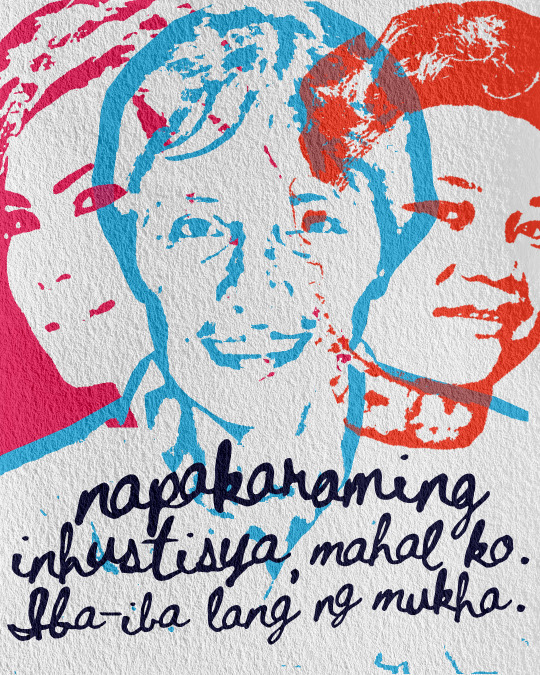
Hango mula sa Dead Balagtas Short: La Mujer Filipina (2017) ni Leona Florentino at Emiliana Kampilan; adaptasyon ng sanaysay ni Leona Florentino (1849-1884) sa parehong pamagat, La Mujer Filipina.
Hindi kailanman maihihiwalay ang danas at pakikibaka ng pagiging babae, sa pagiging parte ng LGBTQIA+, at pagiging Pilipino sa isang lipunang binubulok ng impe, pyudalismo, at burukrata-kapitalismo. Ang pagtakwil nito ay siya ring pagtatakwil sa tunay na kalayaan at dignidad ng ating bansang binuhat ng tatag, sigasig, talino, kalinga, at pagmamahal ng bawat kababaihang Pilipino.
Katarungan para kay Jennifer Laude, at ibang pang mga transwomen na pinaslang at kumakaharap ng karahasan dahil lang sa kanilang pagkakakilanlan.
Hustisya para kay Lenie Rivas, at iba pang mga Lumad na minasaker at dinadahas ng mga militar sa kanilang sariling lupang ninuno.
Panawagan sa paglitaw ni Elizabeth "Loi" Magbanua, lesbiyanang aktibista at organisador, at iba pang mga desaparecidos na buong tapang at pusong naglilingkod para sa bayan.
Ina-alala natin ang kanilang memorya tungo sa isang mundo kung saa'y malaya magdiwang ng kanilang pagkakakilanlan. Mundong may hustisya, respeto, at pagkakapantay-pantay.
--
Para sa Abante, Babae zine ng Gabriela Santa Cruz, California
1 note
·
View note
Photo

Birthday gift ko sa sarili ko, mga librong komiks ng mga magagaling na Filipino komikero at komikera!
Guys, kung bet niyo ang simple pero makabagbag-damdamin na paggunita ng mga araw ng kabataan, basahin niyo ang Meläg ni Bong Redila! Ang galing, parang ang simple lang ng mga guhit niya pero ang eksperto niya sa pagkwento!
At kung trip niyo naman ang kasaysayan, kabaklaan at katibakan, para sa inyo ang Dead Balagtas, Tomo 1: Mga Sayaw ng Dagat at Lupa ni Emiliana Kampilan (@deadbalagtas)! Ang ganda-ganda ng mga ilustrasyon, lalo na yung pag-drowing sa karagatan! At may mga bakla! At mga lesbiyana! At kasaysayan! At ang paborito kong alamat ng paglikha, ang tungkol kina Tungkung-Langit at Alunsina (o Laon-Sina)!
Kung mahilig kayo sa mga komiks, o kahit mga kwento lang, basahin niyo ‘tong dalawang ito. Hindi kayo magsisisi.
4 notes
·
View notes
Photo

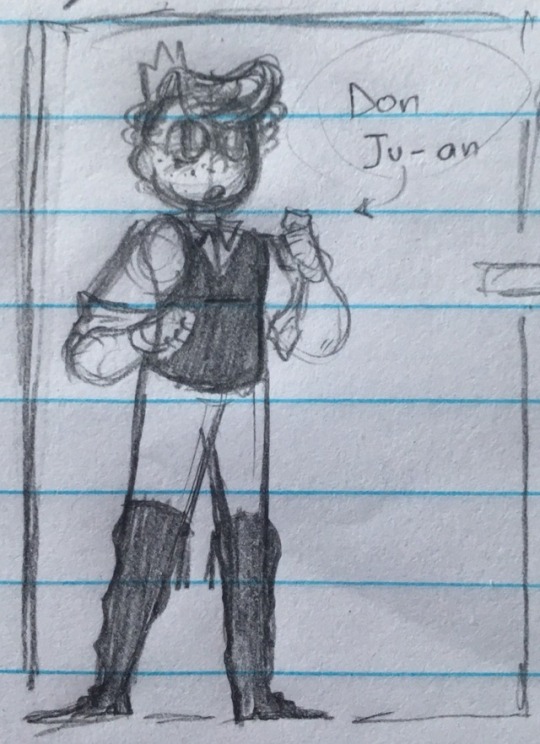

some stupid idiot boys
#sketch dump#hey anon who said all my characters looked the same... @ me and continue to give me advice please...... thank u....#hmmmm to tag oc or not to tag oc...#to be fair fransisco balagtas has been dead for hundreds of years and those last 4 boys aren’t characters............#I mean what could I possibly lose :)) no one knows who they are anyway :))#silvercatocs#ibong adarna#ibong adarna AU#shoutout to sofia and maia bc I still love the idiot boys#and girls#collegehumor#but keep it on the DL :////#jake and Amir#guess who the other two are good luck#TRAD#SCRATCH
21 notes
·
View notes
Text
The Literary Forms in Philippine Literature
by: Christine F. Godinez-Ortega
The diversity and richness of Philippine literature evolved side by side with the country's history. This can best be appreciated in the context of the country's pre-colonial cultural traditions and the socio-political histories of its colonial and contemporary traditions.
The average Filipino's unfamiliarity with his indigenous literature was largely due to what has been impressed upon him: that his country was "discovered" and, hence, Philippine "history" started only in 1521.
So successful were the efforts of colonialists to blot out the memory of the country's largely oral past that present-day Filipino writers, artists and journalists are trying to correct this inequity by recognizing the country's wealth of ethnic traditions and disseminating them in schools and in the mass media.
The rousings of nationalistic pride in the 1960s and 1970s also helped bring about this change of attitude among a new breed of Filipinos concerned about the "Filipino identity."
Pre-Colonial Times
Owing to the works of our own archaeologists, ethnologists and anthropologists, we are able to know more and better judge information about our pre-colonial times set against a bulk of material about early Filipinos as recorded by Spanish, Chinese, Arabic and other chroniclers of the past.
Pre-colonial inhabitants of our islands showcase a rich past through their folk speeches, folk songs, folk narratives and indigenous rituals and mimetic dances that affirm our ties with our Southeast Asian neighbors.
The most seminal of these folk speeches is the riddle which is tigmo in Cebuano, bugtong in Tagalog, paktakon in Ilongo and patototdon in Bicol. Central to the riddle is the talinghaga or metaphor because it "reveals subtle resemblances between two unlike objects" and one's power of observation and wit are put to the test. While some riddles are ingenious, others verge on the obscene or are sex-related.
The proverbs or aphorisms express norms or codes of behavior, community beliefs or they instill values by offering nuggets of wisdom in short, rhyming verse.
The extended form, tanaga, a mono-riming heptasyllabic quatrain expressing insights and lessons on life is "more emotionally charged than the terse proverb and thus has affinities with the folk lyric." Some examples are the basahanon or extended didactic sayings from Bukidnon and the daraida and daragilon from Panay.
The folk song, a form of folk lyric which expresses the hopes and aspirations, the people's lifestyles as well as their loves. These are often repetitive and sonorous, didactic and naive as in the children's songs or Ida-ida (Maguindanao), tulang pambata (Tagalog) or cansiones para abbing (Ibanag).
A few examples are the lullabyes or Ili-ili (Ilongo); love songs like the panawagon and balitao (Ilongo); harana or serenade (Cebuano); the bayok (Maranao); the seven-syllable per line poem, ambahan of the Mangyans that are about human relationships, social entertainment and also serve as a tool for teaching the young; work songs that depict the livelihood of the people often sung to go with the movement of workers such as the kalusan (Ivatan), soliranin (Tagalog rowing song) or the mambayu, a Kalinga rice-pounding song; the verbal jousts/games like the duplo popular during wakes.
Other folk songs are the drinking songs sung during carousals like the tagay (Cebuano and Waray); dirges and lamentations extolling the deeds of the dead like the kanogon (Cebuano) or the Annako (Bontoc).
A type of narrative song or kissa among the Tausug of Mindanao, the parang sabil, uses for its subject matter the exploits of historical and legendary heroes. It tells of a Muslim hero who seeks death at the hands of non-Muslims.
The folk narratives, i.e. epics and folk tales are varied, exotic and magical. They explain how the world was created, how certain animals possess certain characteristics, why some places have waterfalls, volcanoes, mountains, flora or fauna and, in the case of legends, an explanation of the origins of things. Fables are about animals and these teach moral lessons.
Our country's epics are considered ethno-epics because unlike, say, Germany's Niebelunginlied, our epics are not national for they are "histories" of varied groups that consider themselves "nations."
The epics come in various names: Guman (Subanon); Darangen (Maranao); Hudhud (Ifugao); and Ulahingan (Manobo). These epics revolve around supernatural events or heroic deeds and they embody or validate the beliefs and customs and ideals of a community. These are sung or chanted to the accompaniment of indigenous musical instruments and dancing performed during harvests, weddings or funerals by chanters. The chanters who were taught by their ancestors are considered "treasures" and/or repositories of wisdom in their communities.
Examples of these epics are the Lam-ang (Ilocano); Hinilawod (Sulod); Kudaman (Palawan); Darangen (Maranao); Ulahingan (Livunganen-Arumanen Manobo); Mangovayt Buhong na Langit (The Maiden of the Buhong Sky from Tuwaang--Manobo); Ag Tobig neg
Keboklagan (Subanon); and Tudbulol (T'boli).
The Spanish Colonial Tradition
While it is true that Spain subjugated the Philippines for more mundane reasons, this former European power contributed much in the shaping and recording of our literature. Religion and institutions that represented European civilization enriched the languages in the lowlands, introduced theater which we would come to know as komedya, the sinakulo, the sarswela, the playlets and the drama. Spain also brought to the country, though at a much later time, liberal ideas and an internationalism that influenced our own Filipino intellectuals and writers for them to understand the meanings of "liberty and freedom."
Literature in this period may be classified as religious prose and poetry and secular prose and poetry.
Religious lyrics written by ladino poets or those versed in both Spanish and Tagalog were included in early catechism and were used to teach Filipinos the Spanish language. Fernando Bagonbanta's "Salamat nang walang hanga/gracias de sin sempiternas" (Unending thanks) is a fine example that is found in the Memorial de la vida cristiana en lengua tagala (Guidelines for the Christian life in the Tagalog language) published in 1605.
Another form of religious lyrics are the meditative verses like the dalit appended to novenas and catechisms. It has no fixed meter nor rime scheme although a number are written in octosyllabic quatrains and have a solemn tone and spiritual subject matter.
But among the religious poetry of the day, it is the pasyon in octosyllabic quintillas that became entrenched in the Filipino's commemoration of Christ's agony and resurrection at Calvary. Gaspar Aquino de Belen's "Ang Mahal na Passion ni Jesu Christong Panginoon natin na tola" (Holy Passion of Our Lord Jesus Christ in Verse) put out in 1704 is the country's earliest known pasyon.
Other known pasyons chanted during the Lenten season are in Ilocano, Pangasinan, Ibanag, Cebuano, Bicol, Ilongo and Waray.
Aside from religious poetry, there were various kinds of prose narratives written to prescribe proper decorum. Like the pasyon, these prose narratives were also used for proselitization. Some forms are: dialogo (dialogue), Manual de Urbanidad (conduct book); ejemplo (exemplum) and tratado (tratado). The most well-known are Modesto de Castro's "Pagsusulatan ng Dalawang Binibini na si Urbana at si Feliza" (Correspondence between the Two Maidens Urbana and Feliza) in 1864 and Joaquin Tuason's "Ang Bagong Robinson" (The New Robinson) in 1879, an adaptation of Daniel Defoe's novel.
Secular works appeared alongside historical and economic changes, the emergence of an opulent class and the middle class who could avail of a European education. This Filipino elite could now read printed works that used to be the exclusive domain of the missionaries.
The most notable of the secular lyrics followed the conventions of a romantic tradition: the languishing but loyal lover, the elusive, often heartless beloved, the rival. The leading poets were Jose Corazon de Jesus (Huseng Sisiw) and Francisco Balagtas. Some secular poets who wrote in this same tradition were Leona Florentino, Jacinto Kawili, Isabelo de los Reyes and Rafael Gandioco.
Another popular secular poetry is the metrical romance, the awit and korido in Tagalog. The awit is set in dodecasyllabic quatrains while the korido is in octosyllabic quatrains. These are colorful tales of chivalry from European sources made for singing and chanting such as Gonzalo de Cordoba (Gonzalo of Cordoba) and Ibong Adarna (Adarna Bird). There are numerous metrical romances in Tagalog, Bicol, Ilongo, Pampango, Ilocano and in Pangasinan. The awit as a popular poetic genre reached new heights in Balagtas' "Florante at Laura" (ca. 1838-1861), the most famous of the country's metrical romances.
Again, the winds of change began to blow in 19th century Philippines. Filipino intellectuals educated in Europe called ilustrados began to write about the downside of colonization. This, coupled with the simmering calls for reforms by the masses gathered a formidable force of writers like Jose Rizal, Marcelo H. del Pilar, Mariano Ponce, Emilio Jacinto and Andres Bonifacio.
This led to the formation of the Propaganda Movement where prose works such as the political essays and Rizal's two political novels, Noli Me Tangere and the El filibusterismo helped usher in the Philippine revolution resulting in the downfall of the Spanish regime, and, at the same time planted the seeds of a national consciousness among Filipinos.
But if Rizal's novels are political, the novel Ninay (1885) by Pedro Paterno is largely cultural and is considered the first Filipino novel. Although Paterno's Ninay gave impetus to other novelists like Jesus Balmori and Antonio M. Abad to continue writing in Spanish, this did not flourish.
Other Filipino writers published the essay and short fiction in Spanish in La Vanguardia, El Debate, Renacimiento Filipino, and Nueva Era. The more notable essayists and fictionists were Claro M. Recto, Teodoro M. Kalaw, Epifanio de los Reyes, Vicente Sotto, Trinidad Pardo de Tavera, Rafael Palma, Enrique Laygo (Caretas or Masks, 1925) and Balmori who mastered the prosa romantica or romantic prose.
But the introduction of English as medium of instruction in the Philippines hastened the demise of Spanish so that by the 1930s, English writing had overtaken Spanish writing. During the language's death throes, however, writing in the romantic tradition, from the awit and korido, would continue in the novels of Magdalena Jalandoni. But patriotic writing continued under the new colonialists. These appeared in the vernacular poems and modern adaptations of works during the Spanish period and which further maintained the Spanish tradition.
The American Colonial Period
A new set of colonizers brought about new changes in Philippine literature. New literary forms such as free verse [in poetry], the modern short story and the critical essay were introduced. American influence was deeply entrenched with the firm establishment of English as the medium of instruction in all schools and with literary modernism that highlighted the writer's individuality and cultivated consciousness of craft, sometimes at the expense of social consciousness.
The poet, and later, National Artist for Literature, Jose Garcia Villa used free verse and espoused the dictum, "Art for art's sake" to the chagrin of other writers more concerned with the utilitarian aspect of literature. Another maverick in poetry who used free verse and talked about illicit love in her poetry was Angela Manalang Gloria, a woman poet described as ahead of her time. Despite the threat of censorship by the new dispensation, more writers turned up "seditious works" and popular writing in the native languages bloomed through the weekly outlets like Liwayway and Bisaya.
The Balagtas tradition persisted until the poet Alejandro G. Abadilla advocated modernism in poetry. Abadilla later influenced young poets who wrote modern verses in the 1960s such as Virgilio S. Almario, Pedro I. Ricarte and Rolando S. Tinio.
While the early Filipino poets grappled with the verities of the new language, Filipinos seemed to have taken easily to the modern short story as published in the Philippines Free Press, the College Folio and Philippines Herald. Paz Marquez Benitez's "Dead Stars" published in 1925 was the first successful short story in English written by a Filipino. Later on, Arturo B. Rotor and Manuel E. Arguilla showed exceptional skills with the short story.
Alongside this development, writers in the vernaculars continued to write in the provinces. Others like Lope K. Santos, Valeriano Hernandez Peña and Patricio Mariano were writing minimal narratives similar to the early Tagalog short fiction called dali or pasingaw (sketch).
The romantic tradition was fused with American pop culture or European influences in the adaptations of Edgar Rice Burroughs' Tarzan by F. P. Boquecosa who also penned Ang Palad ni Pepe after Charles Dicken's David Copperfield even as the realist tradition was kept alive in the novels by Lope K. Santos and Faustino Aguilar, among others.
It should be noted that if there was a dearth of the Filipino novel in English, the novel in the vernaculars continued to be written and serialized in weekly magazines like Liwayway, Bisaya, Hiligaynon and Bannawag.
The essay in English became a potent medium from the 1920's to the present. Some leading essayists were journalists like Carlos P. Romulo, Jorge Bocobo, Pura Santillan Castrence, etc. who wrote formal to humorous to informal essays for the delectation by Filipinos.
Among those who wrote criticism developed during the American period were Ignacio Manlapaz, Leopoldo Yabes and I.V. Mallari. But it was Salvador P. Lopez's criticism that grabbed attention when he won the Commonwealth Literay Award for the essay in 1940 with his "Literature and Society." This essay posited that art must have substance and that Villa's adherence to "Art for Art's Sake" is decadent.
The last throes of American colonialism saw the flourishing of Philippine literature in English at the same time, with the introduction of the New Critical aesthetics, made writers pay close attention to craft and "indirectly engendered a disparaging attitude" towards vernacular writings -- a tension that would recur in the contemporary period.
The Contemporary Period
The flowering of Philippine literature in the various languages continue especially with the appearance of new publications after the Martial Law years and the resurgence of committed literature in the 1960s and the 1970s.
Filipino writers continue to write poetry, short stories, novellas, novels and essays whether these are socially committed, gender/ethnic related or are personal in intention or not.
Of course the Filipino writer has become more conscious of his art with the proliferation of writers workshops here and abroad and the bulk of literature available to him via the mass media including the internet. The various literary awards such as the Don Carlos Palanca Memorial Awards for Literature, the Philippines Free Press, Philippine Graphic, Home Life and Panorama literary awards encourage him to compete with his peers and hope that his creative efforts will be rewarded in the long run.
With the new requirement by the Commission on Higher Education of teaching of Philippine Literature in all tertiary schools in the country emphasizing the teaching of the vernacular literature or literatures of the regions, the audience for Filipino writers is virtually assured. And, perhaps, a national literature finding its niche among the literatures of the world will not be far behind.
22 notes
·
View notes
Text
Book Collection
I had to dust down my bookshelf and it was a good opportunity to take some photos of my books! This is most of my collection, though some are up on my really high shelf and so were not included ^^; If I clean that I’ll just add a follow-up. (also long post and really bad photos I’m so sorry)


So first of all are my two most favorite series ever, the whole Septimus Heap series + the Pathfinder trilogy by Angie Sage, and the Mistmantle Chronicles by M.I. McAllister (I’m missing the last book though....). I love them too much that even after being taught to disembowel literature for my Creative Writing course, you can’t ask me for an objective critique. I suppose some people will disagree and say that you should look at your favorite things even more critically, but I just can’t. I’m not good at critiquing anyway.

Here are three of my favorite short novels. I lean towards fantasy most of the time, but these three were very well written fiction (Because of Winn-Dixie is realistic fiction, and both A Single Shard and Island of the Blue Dolphins are historical fiction, I think?) A Single Shard is really good, I want to look at Linda Sue Park’s other works.
After settling on comics as my thesis I ended up adding much more visual lit and art books to my collection. I rarely buy novels now, unless a really intriguing one catches my eye at a booksale.
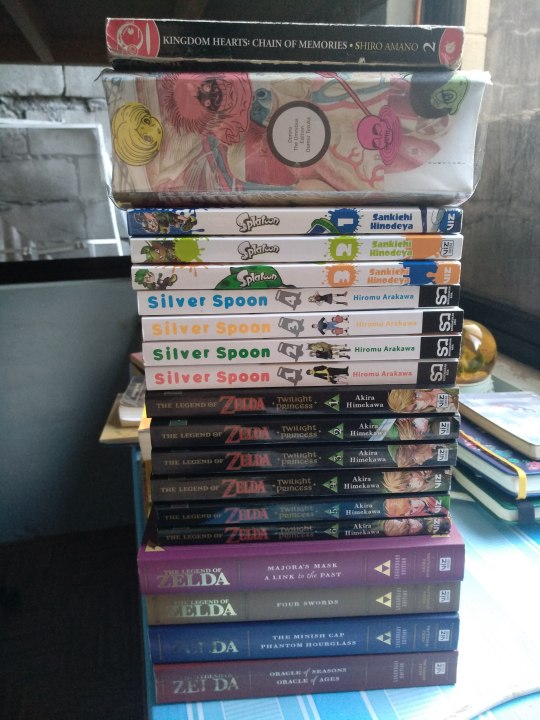
So here’s my manga collection! With an obvious bias towards Akira Himekawa’s LoZ mangas (ironically I still haven’t bought the OoT one, which is the first of the Zelda mangas I think?) I wish I could buy the other volumes of Silver Spoon, it’s a really good read. The KH manga I was luck enough to catch at a booksale for only PhP 65, which is hardly above $1! The Zelda mangas I bought at Fully Booked (same goes for my art books) I wish there was a Fully Booked closer to me, the only other bookstores are National Book Sale (which are 70% school supplies and 30% books and usually don’t carry comics) and booksales.

Now for Filipino Komiks! The reason I got really interested in comics as an area of study is Rob Cham’s silent graphic novel, Light. Before that, me and my family have been reading whatever volumes of Pugad Baboy we could get, so the really ratty looking ones are the ones we’ve managed to keep up to the present time (I also have the giant copy of Pugad Baboy X but didn’t get to include it here). Thankfully, National Book Store stocks Light and Lost, but that is for usually for bigger malls (they used to have Pugad Baboy, but now I rarely see it there, but my copies of Kikomachine Komix are from there too). Dead Balagtas’s Tomo 1 (which is really gorgeous!) I was able to get at a comic event my college organization held at the university. However, Ella Arcangel, Elmer, 12 and 14 were bought at Komikon, which I was lucky enough to attend in 2018. Sadly, Komikon is probably the only best opportunity to buy most Filipino comic stuff, and I live too far from Manila to go every time. I wish I can go again. I was able to meet sir Pol Medina Jr. and sir Gerry Alanguilan at Komikon, I even got my copy of Elmer sighed. Rest in peace, sir Alanguilan :<
Maybe I’ll make another post detailing more Filipino komiks stuff? I really have a lot of feelings on this subject haha.

Now for miscellaneous English comics. I included Arzach though that book is a novelization of certain stories (it does have some illustrations though!) Hopefully I can buy an actual compilation of Arzach comics sometimes, it’s something I’m really interested in. That aside, most of these books were from the Big Bad Wolf Booksale (look, book sales are just my weakness, ok). I really enjoyed these two volumes of Flight and I hope to buy the others sometime. Vogelein I got from...surprise, a book sale! And I really love that one too. What’s not to like with fairies, even clockwork ones.
Now for the jewel of the collection...

The big and beautiful art books which I may or may not have deprived myself of a few lunches to be able to save up enough (also convenience store food dinners wooh! But please don’t copy me, eat healthily when you’re in college!!! >:0)
I also have the Zelda Goddess Books and the BotW art book, which I I think I showed before in a Zelda collection post? But aside from that, here are the Art of Ghibli books which I thank Fully Booked for stocking. Howl’s Moving Castle was my first purchase because Howl, but man do I love the Nausicaa ad Ponyo art. I was also super, super lucky to get the art book for Kubo and the Two Strings at the Manila International Book Fair! That and a Japanese-only copy of Haikara Walker made my arm ache but I was so stoked to get them. (aand I forgot to include my Splatoon art book and Haikara Walker here. Oops.) I also have sky longing for memories/The Art of Makoto Shinkai up on the top.
I think that’s about it, but I very ready to discuss any of the books above if my rambling didn’t bore you ^^;
2 notes
·
View notes
Text
Traditions affected by Covid 19
I'm Ashely Ann Nicole Tirao , 19 years old. I live in Balagtas, Bulacan. 1st year student in Bulacan State University (BSU) taking up a four years course BSIT. In my Nineteen years of existence it's my first time to really feel the effect of pandemic though this is not the first time have a pandemic cause last 2003 SARS declared also as pandemic. Unlike SARS, Covid 19 reported a million victims around the world.
Filipino are very traditional. Traditions that affected by this Pandemic Covid 19 a virus that spread around the world , a very deadly virus but still has no cure as of this moment and it's sad knowing thousands of people are possitive and hundreds dead but in a positive side the rate of Covid 19 survivor are much more higher compared to the numbers of death here in Phillipines. Government are doing their best to stop the spreading of this pandemic, Fronliners were at risk every day because they are the one whose expose to the Covid patients. Covid 19 has killed thousands of people around the world and millions of positive it's really sad to lose someone who's very important to you that why Government of the Philippines are encouraging people to stay at home to atleast reduce the positive patients. Everyday has a new case, new numbers of death, and new Covid 19 survivor. In this time of pandemic many are suffering like losing someone, being scared because their family member is one of the frontliner, some are sleeping without having a food to eat, some wants to go home but they can't because the're stranded and there's no transportation. Let's just have trust to the government and obey their orders for the sake of our safety, have faith that this will end soon, let's spread our helping hand to people whose in need and pray for everyone's safety. Health is wealth, we should really take care of our selves, be careful because everyone of us has an important role in this world. Lets us spread love because this is what we need aside of having a cure from this Covid 19.
Some of our traditions is affected by Covid 19 and here is it . One of the tradition that affected is the Holy Week. We Filipinos are very particular to this, we always have a specific week to remember how Jesus suffered to save us. It was first time in history to virtually celebrate it because of the Enhance Community Quarantine implemented by the government to ensure everyone's safety and to prevent the spreading of this Pandemic Covid 19. Masses are suspended and cancel Holy Week rituals because Government discouraged a mass gathering or any kind of gathering to reduce the possible cases. Hundreds are death because of this pandemic since then the family of victims are prohibited to see the bodies and immediately cremate it to make sure that it will not be a cause of spreading and Government restrict funeral. The family didn't have a chance to see the body of their love one's, they didn't have a chance to properly mourn, they didn't have a chance to send the body in cemetery. Losing a love ones is hard, what more if we didn't have a chance to be with them in times of their suffering, we didn't have a chance to hug them hold them before they close their eyes and be at peace. Family is very important to us that we would give all that we have just to save them or longer their life but because of this pandemic we are restricted to see them and have a close contact. This pandemic brought so much to us but let's have faith that this will end soon. Keep safe for our self and for the others.
Watch this video to know the symptoms of Covid 19.
youtube
Watch this video be aware on how to prevent Covid 19.
https://youtu.be/1APwq1df6Mw
youtube
1 note
·
View note
Text
The Gang
Lucille Bristoll (Familiar: Apollo the Golden Retriever) Age: 13
Lives in the NMR (Non-Magic Realm)
Homeschooled bc her mom is paranoid
Really smart bc she reads and reads
Loves chess
Her only companion is her shadow. She can animate it to play chess with her
Likes to bake
Caleb Astor (Familiar: Owl) Age: 13
Gentle Giant
The 1st person to trust Lucille
Makes colorful crystals for his friends. He keeps the other half and makes a bracelet out of them.They glow because his friends are alive.
Is in the Quadball team in his second year and wants to be the ace
Ashry Hearst (Familiar: Cameron the Chameleon) Age: 13
Jokester
Hated Lucille for a year or so but eventually befriended her
Never studied a day in his life
His father is non-magical so he studied in a normal elementary school
He’s very good with riddles and literature but he tries to hide it
Jock vibe
Is also on the Quadball team
Manami Tsukiko (Familiar: Spiritual Fox) AGe: 13
Takes down notes when Caleb and Ashry are too tired in their practices
Is in the Racing Team
Her brother was kidnapped and believed to be dead
Lives with her relatives but feels like a burden
Akiva Astor (Familiar: Kaj the Tabby Cat) Age: 14
Loves Quadball so much she wants to go professional
Makes bad jokes and snorts afterwards
One of the smartest students in her batch
She’s a cousin of Caleb, a year older than him so she calls him ‘baby cousin’
Really clumsy and her fingers are bandaged bc she practices too much
Kai Balagtas (Familiar: Danger Noodle the Venomous Snake) Age: 14
A talented libero in quadball. Is awarded ‘Best Libero under 19’
Naturally intelligent and argues with his professors if he isn’t sleeping
Best friends with Akiva bc they meet at competitions
Overprotective over friends
Impulsive as hell and his heart on his sleeve
Evie Age: 14
Wore a cloth around her eyes bc her father says the power she has is a curse
she doesn’t deserve to see the world and vice versa, learned helplessness
Is in a witch hunting organization called Withunori
She’s a trained sniper and is terrifyingly accurate at it
Wears dresses
Emmerson: Age: 11
Has been trained in martial arts and likes to use daggers
Views Evie as his only family in the Withunori
Hates their father bc he beats them up and calls it ‘training’
The only Water Elemental to have control over blood and water
Wants to have a better life with his sister but their dad wants them to take over Withunori
Aella Coventin Age: 13
Is a germaphobe and would rather bow than shake hands or hug
She used to be a really sick child so she was homeschooled and became very religious for comfort
Could see people’s auras or like how their souls look like
Paints landscapes and sells them for her charity
Is friends with Tsukiko and has a huge crush on Caleb
3 notes
·
View notes
Text

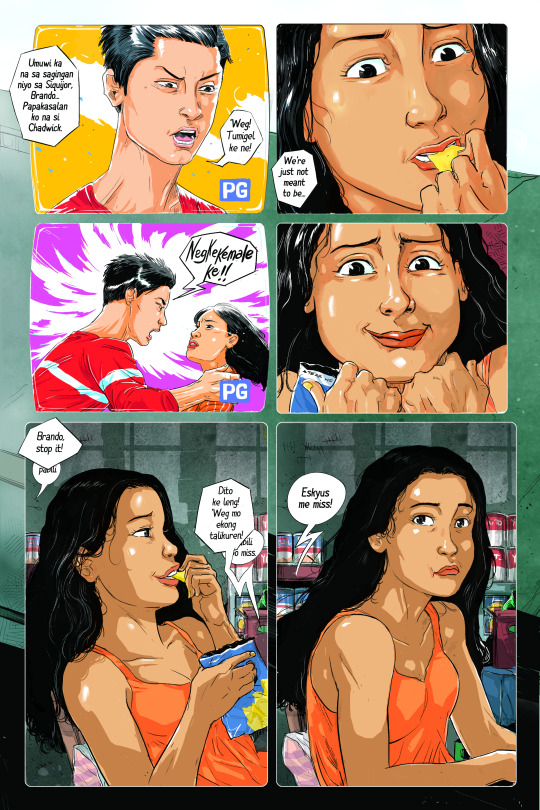



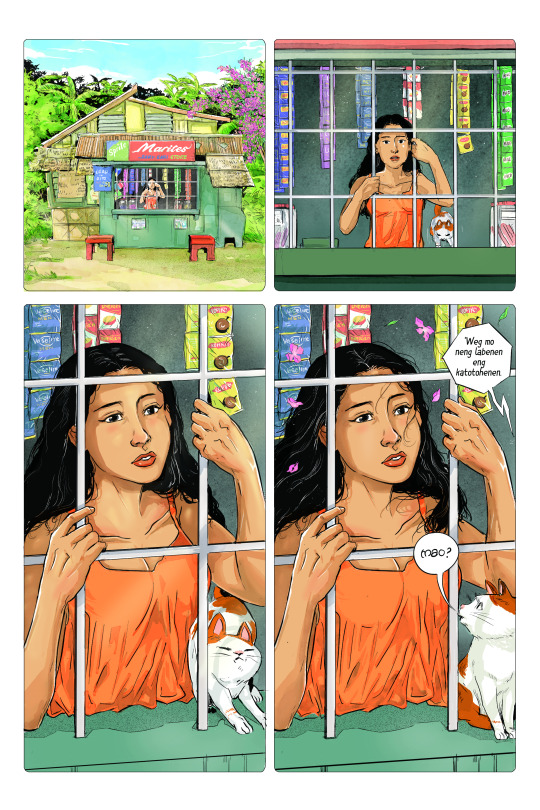

"Keep da Change!" c. 2018 from "Ligaw-Tingin", a komik anthology of Filipina wlw komiks published with Gantala Press.
#filipino komiks#wlw#girls love#filipina#sapphic#gay girls#ligaw tingin#gantala press#dead balagtas#komiks#comics#filipina creators
122 notes
·
View notes
Text
3 dead, 10 nabbed in separate buy-bust ops in Bulacan
#PHnews: 3 dead, 10 nabbed in separate buy-bust ops in Bulacan
CAMP ALEJO SANTOS, Bulacan – Three suspected drug dealers were killed, while 10 individuals were arrested in separate anti-drug operations early Friday morning in the province.
Colonel Lawrence Cajipe, provincial director of Bulacan PNP, identified the neutralized suspects as Carlo Ardenio, resident of Bagong Silang Caloocan City; Joshua Loquente, resident of Meycauayan City and included on the PNP/PDEA watch list; and one still unidentified suspect.
Based on a report, Cajipe said a gunfight ensued during a drug transaction in Melody Plains Barangay Muzon, City of San Jose del Monte around 1:30 a.m.
“Ardenio and his cohort resisted arrest and tried to escape... Ardenio engaged the operatives in a shootout while his unidentified cohort managed to elude arrest on board a motorcycle,” he said.
Recovered were two medium heat-sealed transparent plastic sachets of shabu, one Smith and Wesson .38-caliber pistol, and buy-bust money.
Likewise, Cajipe said that Loquente and his cohort were killed when they fired at the operatives during a buy-bust operation in Barangay Pulong Gubat, Balagtas town around 3:20 a.m. upon sensing that they were dealing with police officers.
Recovered were 11 heat-sealed transparent plastic sachets of shabu, one .38-caliber revolver, and buy-bust money.
Meanwhile, a total of PHP158,200 worth of shabu were confiscated in separate drug busts conducted by the operatives in Barangay Maasim, San Rafael, and Barangay Bagong Nayon in Baliuag, that resulted in the arrest of four drug peddlers.
Six more drug suspects were apprehended in the drug stings conducted by the operatives of San Ildefonso, Bocaue, Guiguinto, Marilao, and Obando police.
Seized were 24 sachets of shabu and buy-bust money.
The arrested suspects and seized pieces of evidence were brought to Bulacan Crime Laboratory for examination while appropriate criminal charges against them are for filing in court. (PNA)
***
References:
* Philippine News Agency. "3 dead, 10 nabbed in separate buy-bust ops in Bulacan." Philippine News Agency. https://www.pna.gov.ph/articles/1122446 (accessed November 21, 2020 at 12:54AM UTC+14).
* Philippine News Agency. "3 dead, 10 nabbed in separate buy-bust ops in Bulacan." Archive Today. https://archive.ph/?run=1&url=https://www.pna.gov.ph/articles/1122446 (archived).
0 notes
Photo

I’m very happy and excited to announce that my new comics, “Paraluman,” will be included in the new anthology from Gantala Press and edited by Dead Balagtas! 💖 Watch out for “LIGAW TINGIN - Kalipunang Komiks ng Pagmamahalang Marilag,” coming this #Pride Month! 🌈
#komix#comics#pride#lgbtq#wlw#women#art#filipina#mga kaibigan kong nasa Pinas#tara magkita-kita tayo sa launch#also kagabi ko lang din nalaman ang ibig sabihin ng marilag#majestic siya beh#alam niyo ba yun kasi di ko alam yun#di kasi ako nakikinig sa klase#ay tapos Paraluman pala is an old Tagalog term for muse#ewan ko lang kung totoo ha#ginoogle ko lang yan
24 notes
·
View notes
Photo
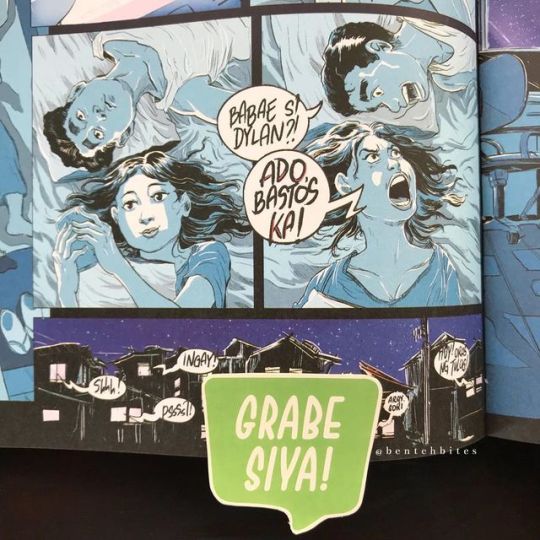
The social relevance of this amazing graphic novel is as multi-layered as its storytelling so I'll just mention the ones that spoke to me personally. • The first is obviously the queerness of it. The book is subdivided into four distinct stories, two of which revolve around non-het couples and these parts take up majority of the book's content. We've got the MM couple that begins in a meet-disaster and becomes a unique friendship, and then a romantic relationship. I loved the part with a passage from the Quran, bec I rarely see gay Pinoy Muslim rep. Then there's the FF relationship between a collegiala activist and a blue-collar worker. I absolutely loved that the story was allowed to run longer than the rest of the stories here. We got to see Anais's and Dylan's stories develop from their personal struggles separately, as well as them as a couple. This is the story that really made me love the whole book. • Next is the non-exploitative representation of the poor an lower class. It is presented as it is in real-life, not glossed over, but also not cruel to the characters. They're living their lives and are allowed to find happiness and joy, and a hopeful future. • And lastly, I loved the geographic prehistory of the country juxtaposed in the contemporary stories. The Folkloric beginnings and the modern parallels matched the comic book's amazing artwork. I'm so glad it's in full-color too! I'm sharing select pages in random to avoid spoilers if you haven't read it yet. :) • So yeah, my rec for #romanceclassBAPbingo for Socially Relevant is Dead Balagtas Tomo 1: Sayaw ng mga Dagat at Lupa by Emiliana Kampilan • Thank u, bes @chachicsbooknook for letting me borrow! ❤️❤️❤️ . . . . #bookstagram #bibliophile #booknerdPH #bookworm #instabooks #bookish #bookishfeature #bookcommunity #alwaysreading #bookstagramersPH #IGreads #books⠀ #LoveWins #ResistTogether #KomiksPH #DeadBalagtas #EmilianaKampilan #SociallyRelevant #readlocalPH #diversebooks #diversereads #BuwanNgMgaAkdangPinoy #QueerLit #PrideReads #Pride #PagesofPride https://www.instagram.com/p/B1k0okegU71/?igshid=1i5p7qpyq9kkz
#romanceclassbapbingo#bookstagram#bibliophile#booknerdph#bookworm#instabooks#bookish#bookishfeature#bookcommunity#alwaysreading#bookstagramersph#igreads#books#lovewins#resisttogether#komiksph#deadbalagtas#emilianakampilan#sociallyrelevant#readlocalph#diversebooks#diversereads#buwanngmgaakdangpinoy#queerlit#pridereads#pride#pagesofpride
0 notes
Text
some more filipino fun facts with the twins
cause it’s independence day that’s why
They were heavily involved with the Filipino society in the Citadel. Enough that they’ve hosted a bunch of events, and most of their friends were Filipino.
Oh that means they were also part of a bunch of plays. Like that adaptation of “Himala,” well okay Gabriela was the understudy to main character. She never actually “played” Elsa. She did however played Sisa in their adaptation of Noli Me Tangere. Jean was in that play too, Noli Me Tangere...as Elias.
There was a revival of the jejemon culture in the 22nd century and Gabriela was part of it. Okay...she doesn’t talk about that at all
Gabriela requested a custom Maria Clara to be made for the anniversary of Port Meridian’s founding. Also she got herself a Barong because she looks cute in it.
She also got Jean a custom made Kadara themed Barong Tagalog... “For your future wedding ;) Or coronation ;)”
Jean has a crush on goyong as well as the dude who played the young Francisco Balagtas in the tv adaptation of his life (in the 22nd century, it doesn’t exist right now lol). He brought the complete series to Andromeda just cause of that...guy. (These ppl are dead omg Jean)
When the twins post on RP612, they don’t post as their usual handles (bioticgod and ectobiotic) but TandangSora and JuanTamad.
2 notes
·
View notes

